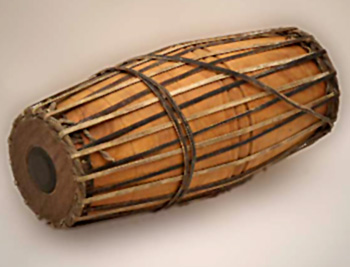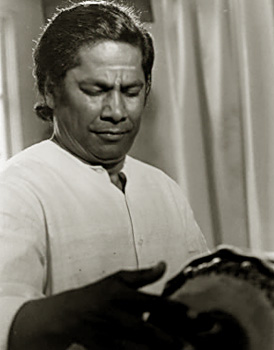 Mridanga is the most ancient among the Indian drums. It is said to have been invented by Lord Brahma to accompany the dancing of Lord Shiva, and to have first been played by Lord Ganesha, the elephant-headed son of Shiva. The very term Mirdanga means made of clay, which indicate that the instrument must originally have been a pottery drum. However, for many centuries now, it has been made of wood. Mridanga is the most dominant percussion instrument in Carnatic music.
Mridanga is the most ancient among the Indian drums. It is said to have been invented by Lord Brahma to accompany the dancing of Lord Shiva, and to have first been played by Lord Ganesha, the elephant-headed son of Shiva. The very term Mirdanga means made of clay, which indicate that the instrument must originally have been a pottery drum. However, for many centuries now, it has been made of wood. Mridanga is the most dominant percussion instrument in Carnatic music.
History of Mridanga
It was one of the most important drums of Bharata`s time, being one of the triumvirate -Mridanga, Panava and Dardura. Even during the period of Sarangadeva, the Mridanga retained its pre-eminent position, for his Tripushkaras were the Mridanga, the Mardala, and the Murja which are all barrel drums. Details of the Mridanga are mentioned in the Natyashastra. The author gives different shapes (myrobalan, barley, cow`s tail) and the position of play (vertical, horizontal, embraced). He further states that "the mridangas are so called because of being made of mrit (earth)". That is, the body or barrel was made of clay; mrit-anga = mridanga. Today it is still one of the best drums in the country.
 Structure of Mridanga
Structure of Mridanga
The Mrindanga, carved from a jackfruit log, is barrel-shaped on the outside. On the inside, the bore toward the two ends is slightly conical. The surfaces of the Mridanga are made in two main sizes. One is approximately twenty five inches long, and sounding within the approximate pitch area of Sa to Re (C to D below middle C). The other is approximately twenty-three inches long and sounding in the pitch area of Ma to Pa (F to G below Middle C). The former is for accompanying male voices, the latter for accompanying female voices, a Veena, or a bamboo flute. The Mridanga has a playing head at each end. Each head is composite; that is, each is made of several layers of skin. The design of the heads, which is extremely complex, is meant to provide maximum clarity, variety, and controllability of tone. The several layers are of cowhide and goatskin. A rim of buffalo thong is braided around the edge of each head. This rim provides an anchor for extremely high tension: buffalo-hide lacing is pulled through it at sixteen points and stretched in a `V` pattern over the body from head to head.
The preparation of the right-hand head once it is lashed to the drum demands great skill on the part of the maker. First, the center hole of the outer skin must be enlarged to fit the required basic pitch of the instrument. This is done by inserting a metal plate between the skins and cutting the top one with a knife. After the hole has been properly cut, the surface of the second skin, which shows through the hole, is again scraped. A thin layer of plain well-boiled rice is applied as adhesive and allowed to dry in the sun. It must be used soon after it is prepared, and it provides the base for the application of the black tuning mixture. This tuning mixture is now applied to the second skin through the hole, giving the head a clear and pleasant musical pitch, and putting the tonic and first partial of the drum into perfect octave relationship to one another. The paste on the right head may last for weeks or even months if the drum is not used constantly. Most professional drummers, however, must change instruments at least once during a performance because the paste begins to chip, affecting the tone. The skin must be scraped completely clean before new paste is applied.
The final stage in preparing the right head is the insertion of thin pieces of straw between the first and second heads. These form radii from the centre to the sixteen points where the thong is lashed to the edge of the head. The two vibrating heads are thereby kept from touching each other, and the tone is noticeably improved. The straws are broken off so as not to extend into the playing area. A tuning paste is also applied to the left head, but it is not a "permanent" paste, as on the right head.
Techniques of playing Mridanga
A number of distinctly different sounds can be produced on the Mridanga. The heads may be hit on the ring of the top skin, on the tuning-paste spot of the second skin, or on both places at once. One, two, or three fingers and even the palm may be used in these different places. Damped or un-damped sounds are possible. A very clear musical pitch, its octave, or a pitch half-step above the basic pitch can be produced.




















